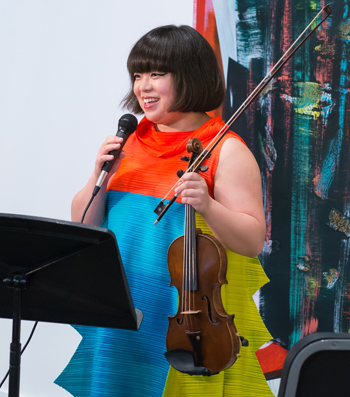by Timothy Robson

“Yura! telling fiddle tales” was a one-woman show, during which Lee not only performed, but offered just enough commentary on the music, with a sly and sometimes self-deprecating sense of humor. With a full house of about 75, the venue was intimate enough that each audience member could feel a part of the performance. The show was performed twice, at 6:30 and 8:30. I attended the second show, witnessing a playlist that covered the gamut from masterpieces by Biber and Bach to bluegrass and Norwegian folk fiddling.
Heinrich Biber’s 1674 “Passacalgia in g (Guardian Angel)” from the Rosenkranz Sonatas opened the concert. The work is based on a four-note descending theme, repeated 65 times with increasingly complex variations. Yura Lee’s clarity of counterpoint and flexibility of pulse captured Biber’s intent that this work was an act of devotion and commemoration of Jesus’s crucifixion.
Yura Lee’s far-ranging interests led her to include two segments of non-classical fiddling. First came two bluegrass fiddle tunes from the Appalachian tradition. The second tune, Bonaparte’s Retreat, was influenced by Scottish folk music. Lee used a violin with three strings tuned to the same note, producing a “bagpipe” effect. Lee played the tunes brilliantly, but the audience gave this fun-filled music the same solemn attention as it did for the Biber. There should have been clapping along the way.
The middle of the recital was given over to three works representing the European Romantic tradition, beginning with Eugène Ysaÿe’s 1924 Sonata No. 5 in G, Op. 27, No. 5, which falls into two interconnected movements, L’Aurore (“Dawn”) and Danse rustique. The dawn music is highly impressionistic and picturesque, with the influences of Debussy everywhere and extensive use of open strings. The rustic dance movement combined open strings with jagged accents, alternating with wispy, evanescent passages similar to the dawn movement. Lee returned to the dance music with brilliant virtuosity.
Romanian composer George Enescu composed his Impressions d’enfance (“Childhood impressions”) in 1940. Yura Lee played “The Fiddler,” noting that Enescu gave extremely detailed performance instructions, almost by the note, in order to achieve a “Gypsy” style. She had clearly internalized all of the instructions; her performance was spontaneous.
Heinrich Wilhelm Ernst’s Grand Caprice on Schubert’s “Erlkönig” seemed tailor-made to show off Yura Lee’s capabilities. Ernst not only includes the vocal line of Schubert’s famous song about a father’s frantic horse ride in an attempt to save his son’s life, but also the thousands of notes in the piano that represent the ride. As a showpiece, Ernst’s transcription has few peers, and Yura Lee dispatched it with great efficiency.
For her second segment of folk fiddling, Lee chose to perform her own transcription of a traditional Norwegian wedding dance on the hardanger fiddle for which the music was written. The fiddle looks like a violin, but has eight or nine strings. Four are bowed, and the remainder lie below and provide sympathetic resonance, giving an eerie, bell-like sound. The piece was full of wonderful tingly dissonances over a drone bass.
Johann Sebastian Bach’s great Chaconne from the unaccompanied violin Partita No. 2 in D minor, one of the monuments of the violin literature, is a work of supreme musical and technical challenges. Just as Yura Lee began the program with a set of Baroque variations, so is Bach’s Chaconne a pinnacle of the variation form. In this case the variations are based on an eight-measure theme, with 64 succeeding variations, beginning in D minor, but with a central, astonishing modulation to D major, ultimately returning to D minor at the end. Yura Lee was at one with the spiritual element of this piece, and it was a worthy ending to this imaginative and satisfying concert.
Photos by Gary Adams.
Published on ClevelandClassical.com June 28, 2016.
Click here for a printable copy of this article




